Smoking brisket to perfection is no easy feat! It makes sense you’d want to enjoy a balanced smoky flavor, juicy and tender meat, and a crunchy bark after all your hard work. That’s why it’s essential to choose the best wood for smoking brisket. We’re here to help you make an informed decision!
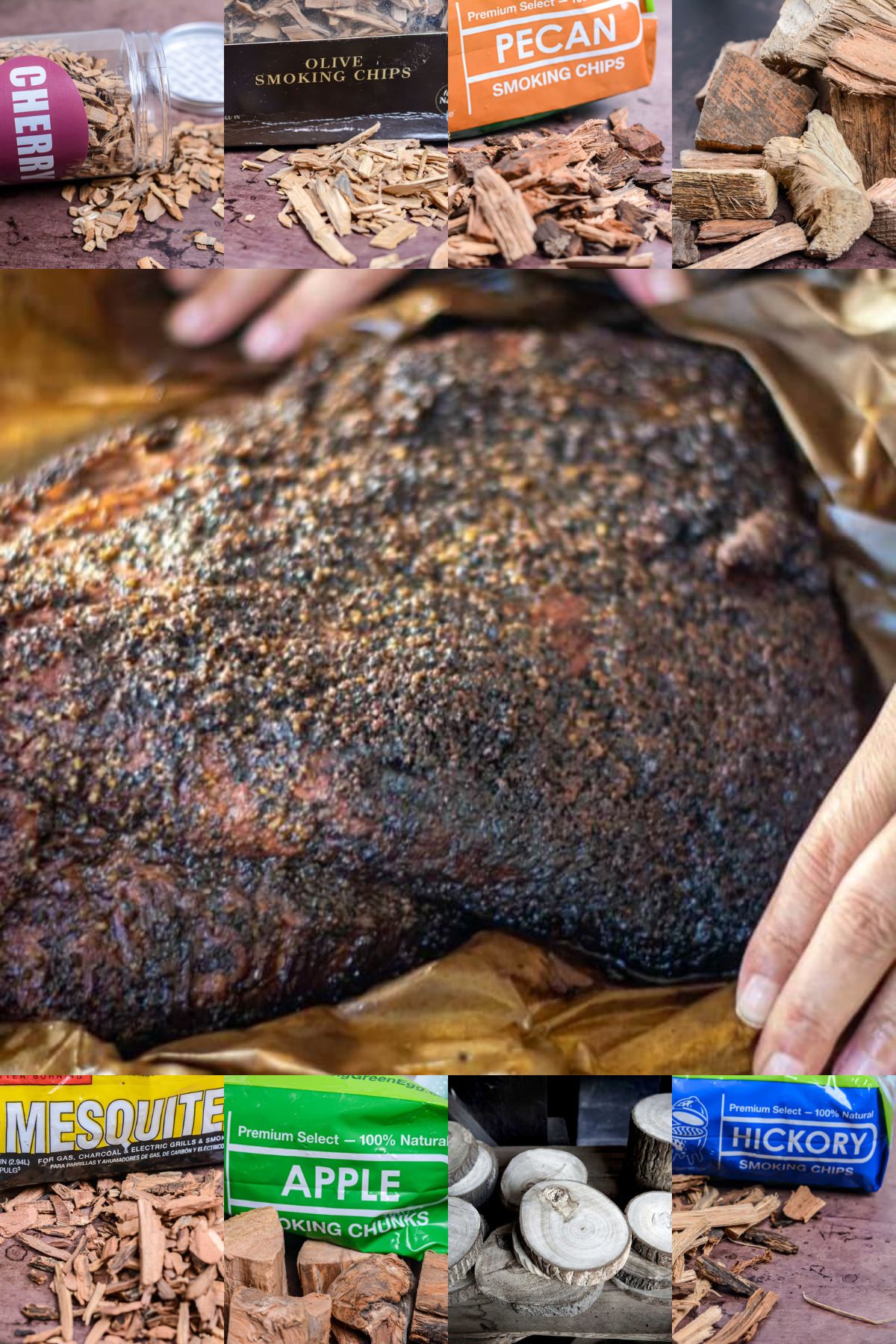
Brisket is a tough cut of meat with a generous layer of fat, so you need to cook it for a longer time at a low temperature to make it perfectly tender.
This gives you plenty of time to provide the meat with a wonderful smoky flavor through your choice of woods.
The wood types below offer you plenty of options and you can also create custom blends. We sorted them based on smoke intensity, from strongest to mildest so you can have an easier time deciding.
Best Wood For Smoking Brisket
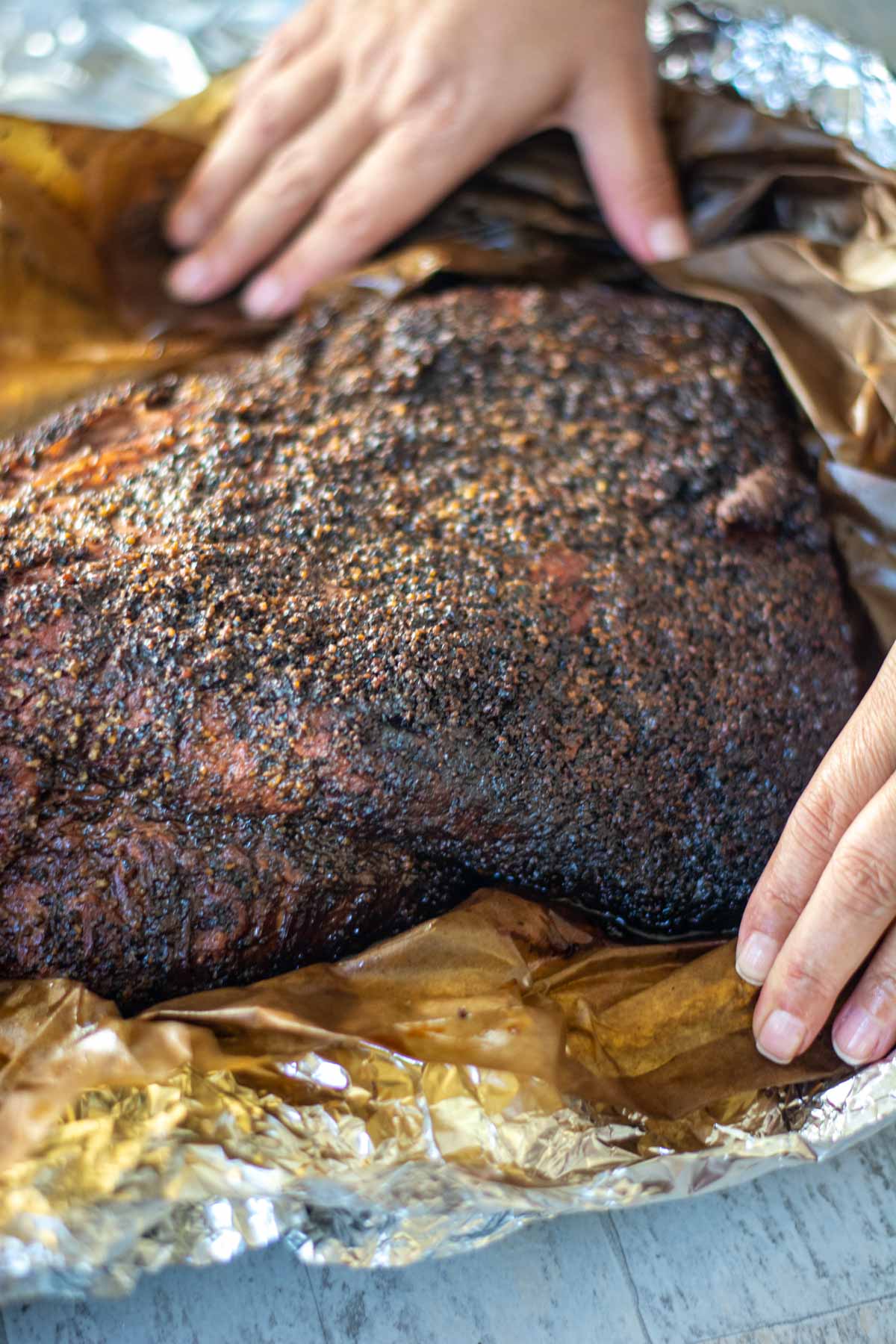
Is it difficult to achieve the perfect smoked brisket? While there are certain steps that help you achieve that tender and juicy meat, the key really is just to be patient.
Regardless if you choose to wrap your brisket or not, the smoking times are long and this is a cut of meat that needs occasional attention.
Various factors can affect how your brisket turns out, from smoking temperature and air humidity to the brisket’s internal temperature and the seasonings you use.
Of course, the smoking wood is another decisive factor for the brisket’s final flavor profile.
Here are our top recommendations when it comes to the best wood for smoking brisket!
| Wood Type | Smoke Intensity | Flavor | Burning Time |
|---|---|---|---|
| Mesquite | Very strong | Earthy, robust | Short, burns quickly |
| Hickory | Strong | Sweet, slightly nutty | Long |
| Red Oak | Medium to strong | Robust, earthy | Long, consistent |
| Pecan | Moderate to strong | Rich, sweet, nutty | Moderate |
| White Oak | Medium | Earthy, balanced | Long, consistent |
| Olive | Moderate | Earthy, similar to mesquite | Moderate to long |
| Cherry | Mild | Mildly smoky, sweet | Moderate |
| Maple | Mild | Slightly smoky, sweet | Long and steady |
| Peach | Mild to moderate | Sweet, fruity | Moderate |
| Pear | Mild | Subtly sweet, mild | Moderate to long |
| Apple | Mild | Sweet and mellow | Moderate |
| Alder | Very mild | Delicate, slightly sweet | Moderate |
| Beech | Very mild | Neutral, mild | Long, steady |
Mesquite
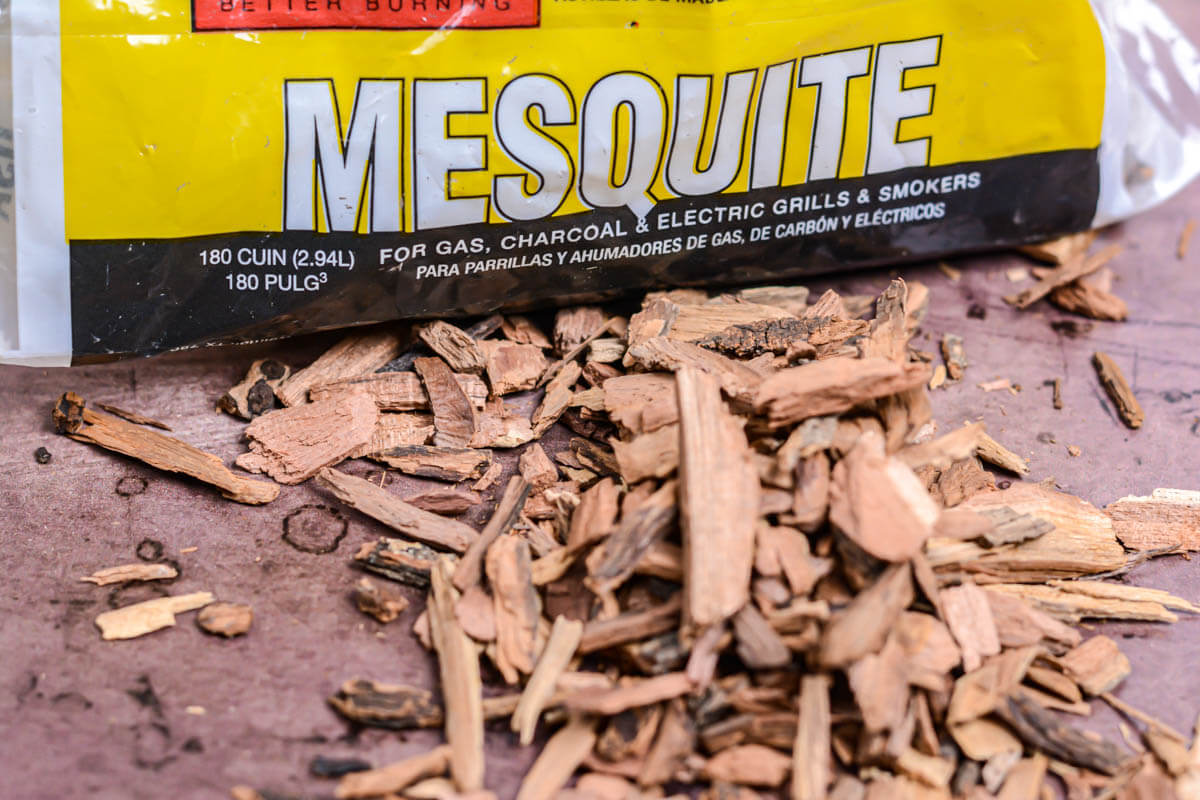
Widely spread in Texas, mesquite is a staple of Texan BBQs. It’s great for infusing your brisket with an intense, earthy flavor.
The punch from mesquite wood is even more amplified by how extremely smoky it burns.
This is thanks to its high content of lignin, the compound responsible for producing smoke upon the combustion of wood.
Keep in mind that mesquite burns pretty fast, so you need to make sure you add more throughout the process.
Also, mesquite produces sparks as it burns, so you may need to put on some safety gear while cooking the brisket.
It isn’t very forgiving and can easily create an overwhelming flavor if you use too much of it. To get around this, I mix it with a mild wood like apple or cherry to tone it down.
As for the color, mesquite adds less color compared to oak or hickory.
Many pit masters use mesquite and hickory in place of one another. While the two share many similarities thanks to their strong flavors, the taste of mesquite smoke packs a more powerful punch than hickory.
I recommend it mainly for beef, as it complements its intense flavor. Because of mesquite’s robust flavor, it’s also one of the best wood for smoking ribs.
Feel free to try it for other quick smoker recipes like these delicious smoked hamburgers.
⭐Smoke Intensity | Very strong, one of the most intense.
⭐Flavor | Earthy, robust.
⭐Burning Time | Short, burns quickly and hot, requires frequent replenishment.
Hickory
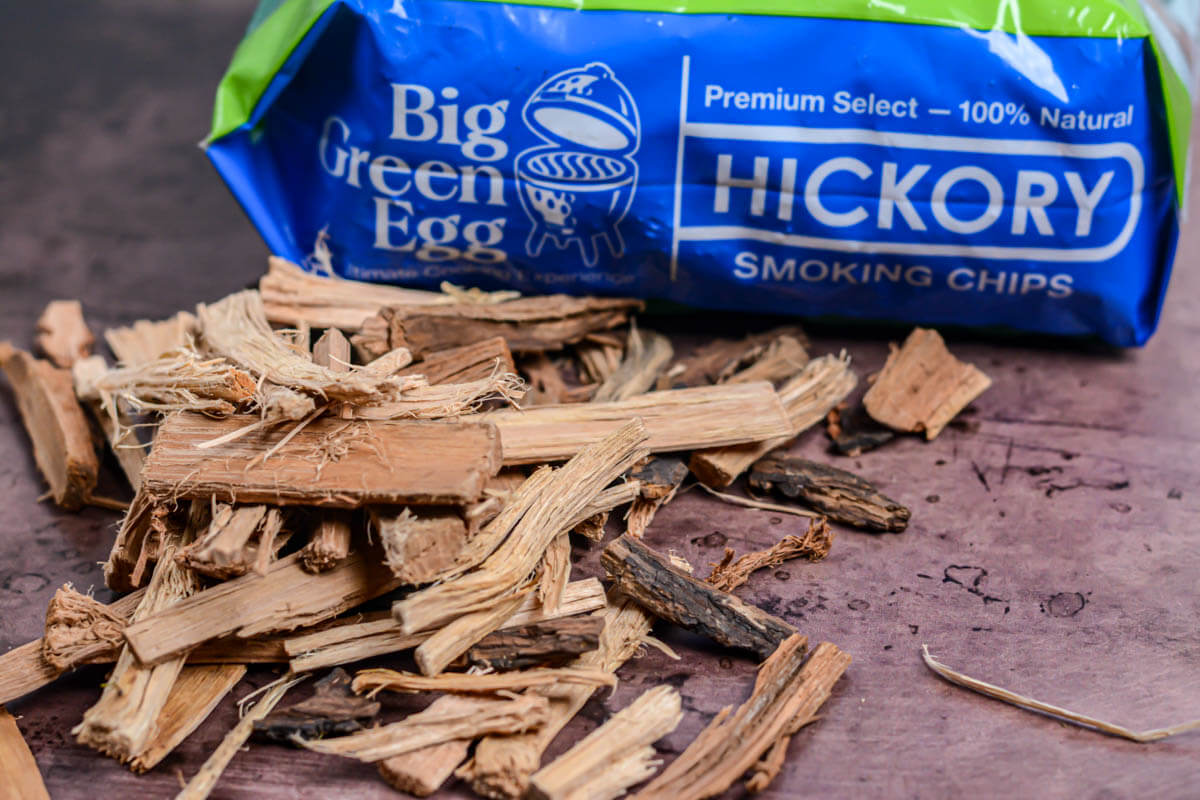
One of the most popular woods to use in smoking red meats, hickory is a hardwood that’s sourced from -yes, you guessed it- the hickory tree.
Hickory is an East Coast native. Its flavor is definitely on the strong side, producing a smoky taste with a sweet and slightly nutty or bacon-like profile.
As such, hickory is a wonderful option for smoking brisket. It’s even considered a staple thanks to its pungent flavor that’s capable of penetrating tough meat and leaving a great taste.
What’s more, hickory is characterized by a long burning time, which makes it easier to manage recipes like brisket that spend a lot of time on the smoker.
Even more, hickory pairs well with other cuts of beef. Use it for smoked flank steak, and smoked top round steak. You can thank me later!
One thing you need to keep in mind is that too much hickory smoke can make the meat bitter, so you can either create a blend with cherry or apple wood or you can use just a few pieces of wood to leave a more subtle flavor.
⭐Smoke Intensity | Strong, pungent.
⭐Flavor | Sweet, slightly nutty flavor, bacon-like.
⭐Burning Time | Long, suitable for extended smoking sessions.
Red Oak
A Southern BBQ staple with a robust, earthy flavor that’s not as harsh as hickory or mesquite. It’s perfect for adding a classic smoky flavor to your beef brisket without being overpowering.
Compared to white oak, the red variety delivers a more intense smoke flavor for those who prefer it.
This type of wood is quite versatile for smoking meats as it also pairs nicely with pork and poultry, not just beef.
⭐Smoke Intensity | Medium to strong, less intense than hickory but more robust than white oak.
⭐Flavor | Robust, earthy, with a more aggressive profile than white oak.
⭐Burning Time | Long, consistent burn, perfect for extended smoking sessions.
Pecan
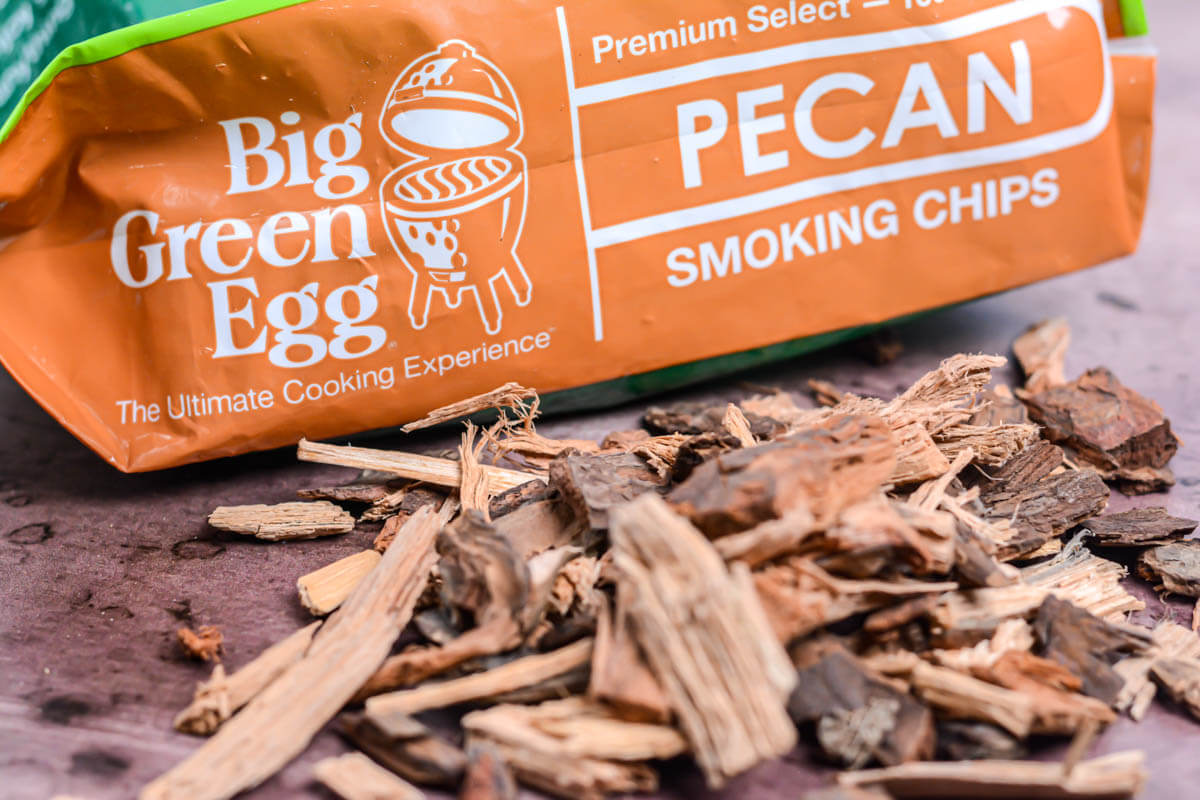
Pecan wood is a hardwood known for possessing a rich and sweet flavor. What sets it apart from other woods is its strong nutty bouquet.
As such, it’s not a surprise that pecan wood offers a more intense flavor compared to other fruit woods.
But don’t worry, it doesn’t deliver as powerful of a blow as mesquite or hickory.
I wouldn’t worry about pecan turning your brisket bitter but don’t go overboard with it anyways.
Sometimes I like to mix pecan with maple or oak wood to mellow out the sweetness a bit.
If you’re a beginner pit master, I recommend you experiment with pecan on easy-to-smoke meats like these smoked Cornish hens.
⭐Smoke Intensity | Moderate to strong, less intense than hickory.
⭐Flavor | Rich, sweet, with a distinctive nutty aroma.
⭐Burning Time | Moderate, can be mixed with other woods for extended smoking.
White Oak
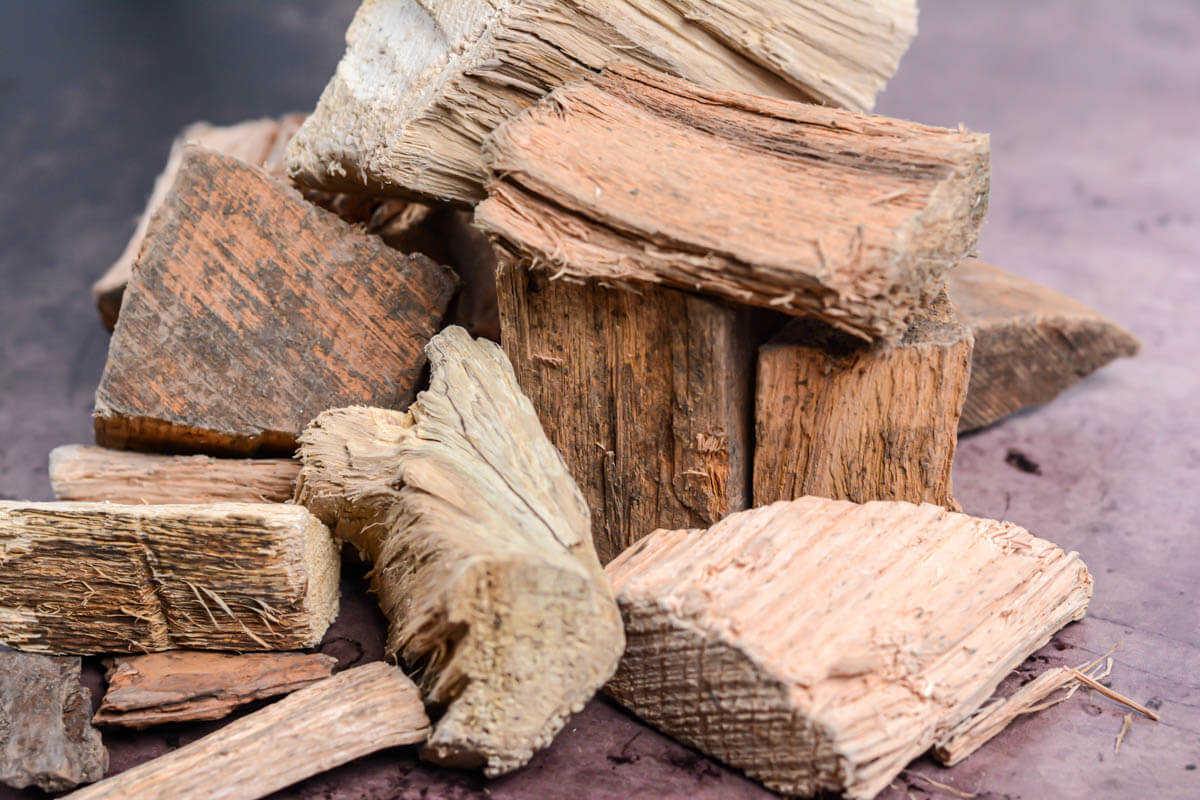
Oak is a hardwood with an excellent reputation when it comes to smoking meat.
Native throughout most of the northern hemisphere, oak is also one of the most readily available woods you can get your hands on.
I love it for brisket smoking thanks to its medium-strength flavor that gives meat the complexity it needs without being too bold.
The earthiness of oak complements brisket so well that you really don’t have to worry about it overpowering the meat like with hickory or mesquite.
Looking for other meats to experiment with oak? This smoked chuck roast gets such a balanced, appetizing flavor when oak wood is used!
Or go for a faster smoked meat recipe like poor man’s burnt ends so you don’t keep the guests waiting for too long.
Another reason why oak is a fantastic choice to smoke brisket is its longevity.
This forgiving wood produces a moderately smoky aroma. It’s the best option for a Texas-style brisket, with a deep-colored smoke that adds sophistication to your brisket’s flavor profile.
What Is Post Oak And How Is It Different From Other Types Of White Oak?
You might have heard of post oak, which is a type of white oak, native to the eastern and central United States. Its scientific name is Quercus stellata.
It is a commonly used wood for smoking brisket and other meats in Texas barbecue culture which makes sense because it is native to this area.
Post oak has a milder and sweeter smoke flavor compared to other types of oak. However, it might not be easily available in your region so you can use regular white oak smoking wood if that is the case.
⭐Smoke Intensity | Medium, less intense than hickory wood.
⭐Flavor | Earthy, balanced, not overpowering.
⭐Burning Time | Long, consistent burn, ideal for longer smoking.
Olive
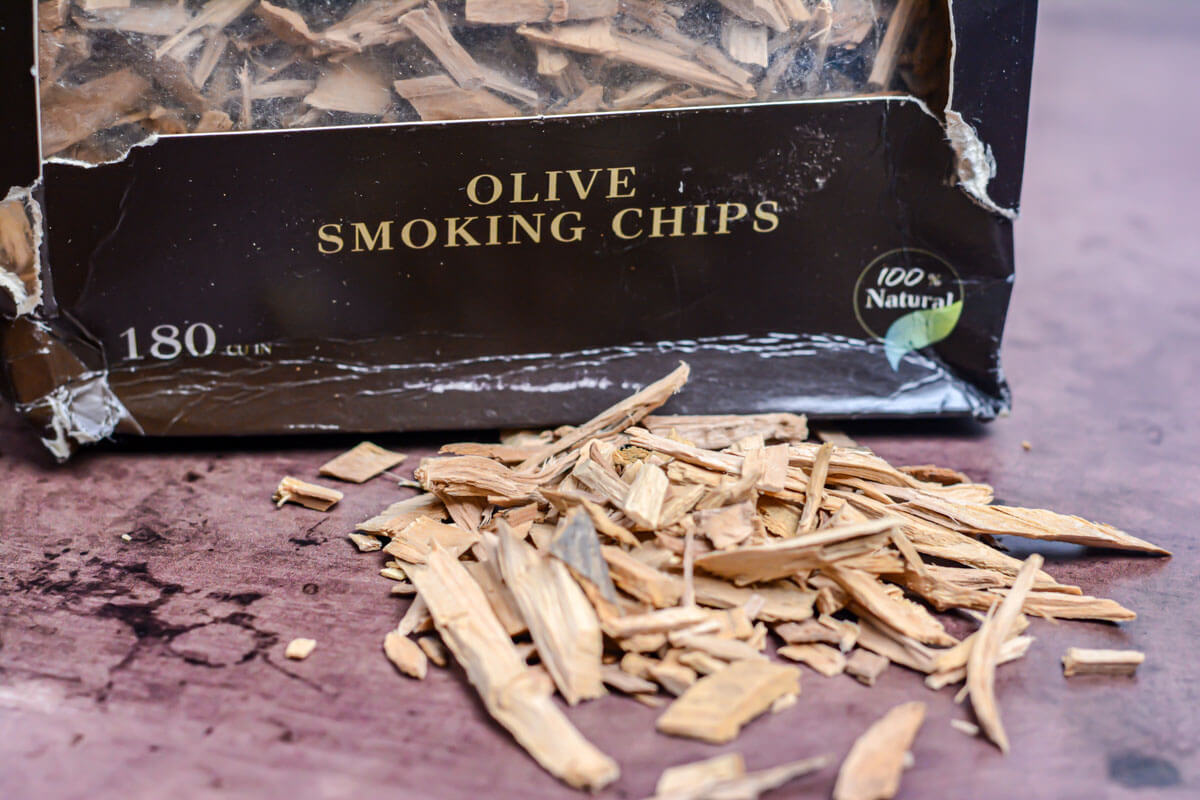
Olive wood may very well be the least popular type of wood on today’s list, but it deserves more recognition.
It’s a terrific alternative to mesquite wood if you’re looking for a similar earthy, smokey flavor that’s not as powerful. Olive wood is also more forgiving and blendable.
⭐ Smoke Intensity | Moderate, less intense than mesquite.
⭐ Flavor | Earthy, similar to mesquite but milder.
⭐ Burning Time | Moderate to long, good for longer smoking sessions.
Cherry
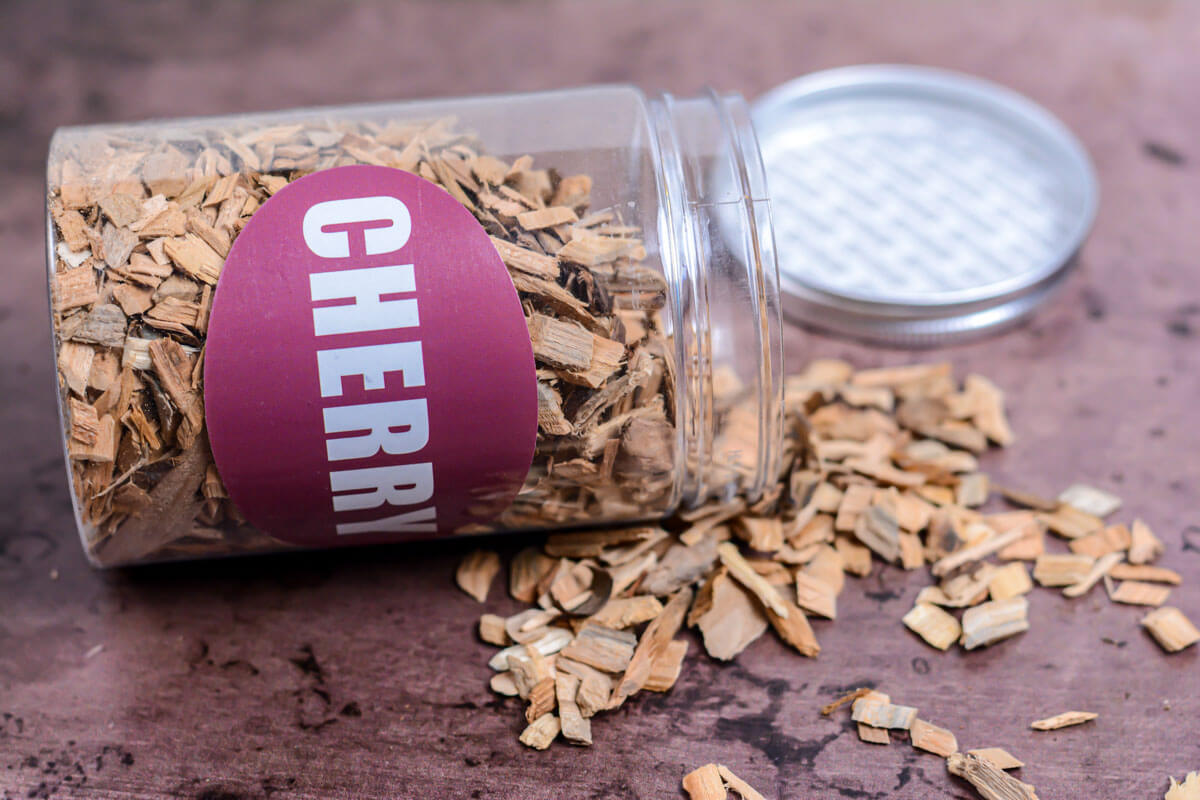
Do you prefer a milder smoky and slightly sweet brisket? Consider cooking it over cherry wood.
But this wood isn’t just known for its subtle flavor. It also does an excellent job of adding color to the bark of your brisket, turning it into a dark red sight of deliciousness!
It’s quite versatile for smoking meat as it pairs nicely with beef, pork, poultry, lamb, fish, seafood, and even cheese!
I love how this wood affects milder-flavored meats. It was excellent for these smoked beer-brined turkey thighs as you could still taste the aroma of the beer brine.
If you feel like powering up the flavor of cherry wood, mix it with maple, hickory, or oak.
Each of these combos delivers a stronger kick with a more complex smoke profile.
⭐Smoke Intensity | Mild, subtle.
⭐Flavor | Mildly smoky with a hint of sweetness.
⭐Burning Time | Moderate, often mixed with stronger woods for longer cooking.
Maple
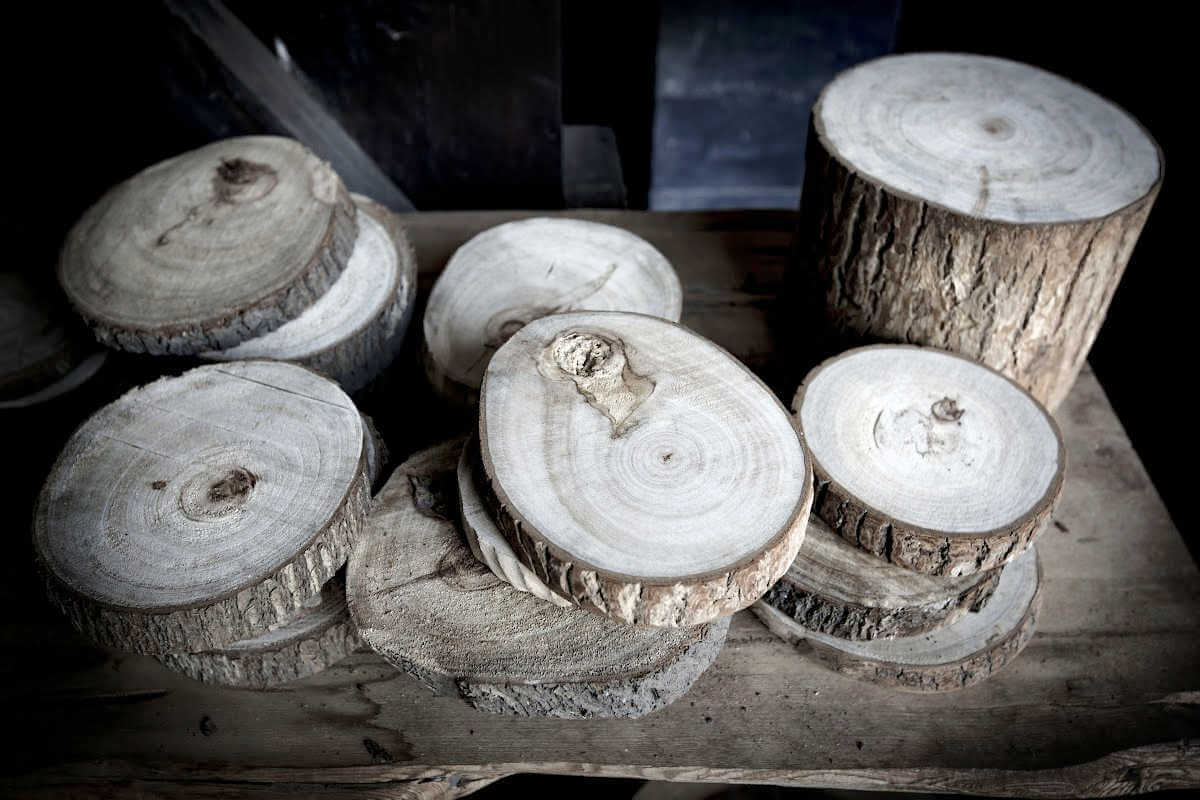
Acer or maple trees are the source of the lifelong companion to pancakes; maple syrup. But that’s not all — they’re also the source of a wonderful wood for grilling and smoking.
Maple wood is common in North America. It’s a favorite among grilling lovers thanks to its mild smoky flavor and subtle sweet notes.
Paired with brisket, it creates a delicious taste that many people find pleasant and not at all overwhelming.
In fact, maple wood is very unlikely to over-smoke your brisket, so it should be on the top of your list of woods to try if you’re just getting into smoking meats.
As for the aroma, it’s pretty much a case of “smells like it tastes”. Its scent is lightly smoky with a hint of sweetness.
Maple offers extended steady burns that are especially needed for cooking brisket.
Interestingly enough, this wood produces a dark-colored, rich smoke that can trick you into assuming it carries a strong flavor.
Because of its subtle bouquet, it’s also great for quick-smoker recipes like poultry. Maple perfectly complements smoked chicken quarters, smoked chicken wings, and even a smoked whole chicken.
⭐Smoke Intensity | Mild, subtle.
⭐Flavor | Slightly smoky with sweet undertones.
⭐Burning Time | Long and steady, suitable for extended smoking sessions.
Peach
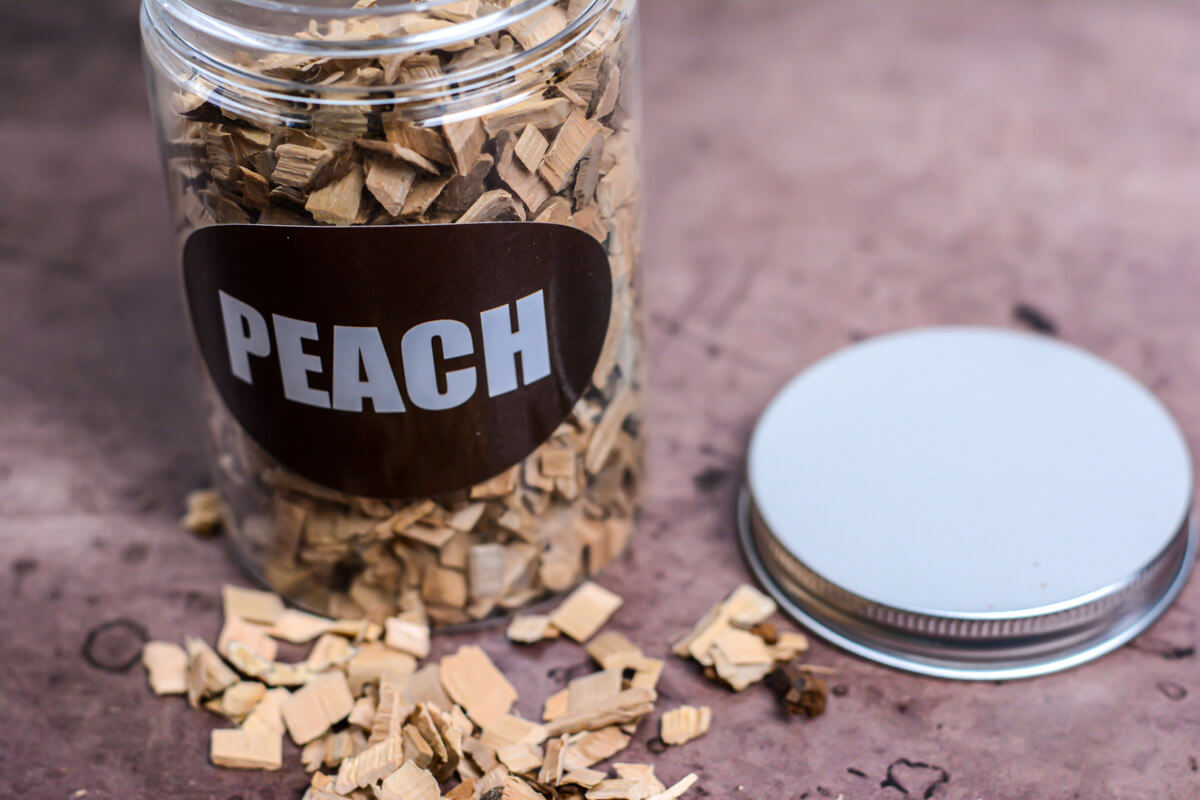
The wood of peach trees will infuse your brisket with a sweet, fruit smoke that’s milder than hickory, mesquite, pecan, and oak.
Peach wood offers a consistent burn, making it a good choice for longer smoking sessions. You can also use it for smoking pork and poultry as it enhances the meat’s natural flavors without overpowering them.
⭐Smoke Intensity | Mild to moderate.
⭐Flavor | Sweet, fruity.
⭐Burning Time | Moderate, consistent burn.
Pear
Like most fruit woods, pear wood has a mild and subtly sweet smoke. It might not be the most popular choice for smoking brisket but it certainly works if you prefer a light smoky flavor.
The subtle nature of pear wood makes it suitable for various smoked dishes and meats.
It also has a steady burn so you can use it for smoking larger cuts of meat that need to stay in the smoker for a longer time.
⭐Smoke Intensity | Mild.
⭐Flavor | Subtly sweet, mild.
⭐Burning Time | Moderate to long.
Apple
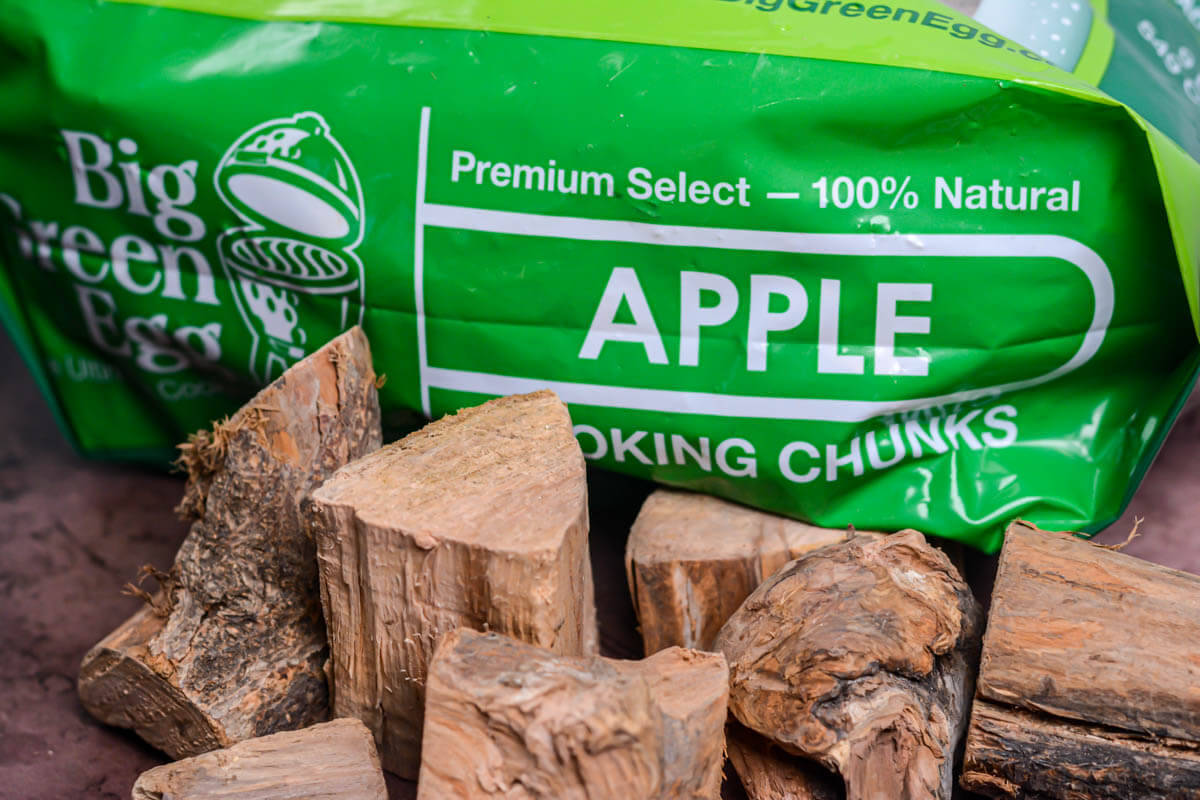
Last but not least, you can use apple wood to smoke your brisket. It’s similar to other fruit woods when it comes to delivering a sweet flavor to meat, but it’s mellower with a very mild smokiness.
Some folks may think that apple wood is too weak to be used alone for cooking brisket.
If you agree, then you can mix it with a stronger type of wood such as oak or mesquite for a bolder taste.
On a side note, apple wood infuses a gentle smoky flavor into the meat, and that’s why it works great for smoked turkey and smoked chicken thighs.
⭐Smoke Intensity | Very mild.
⭐Flavor | Sweet and mellow, with very subtle smokiness.
⭐Burning Time | Moderate, often mixed with stronger woods for longer cooking.
Alder
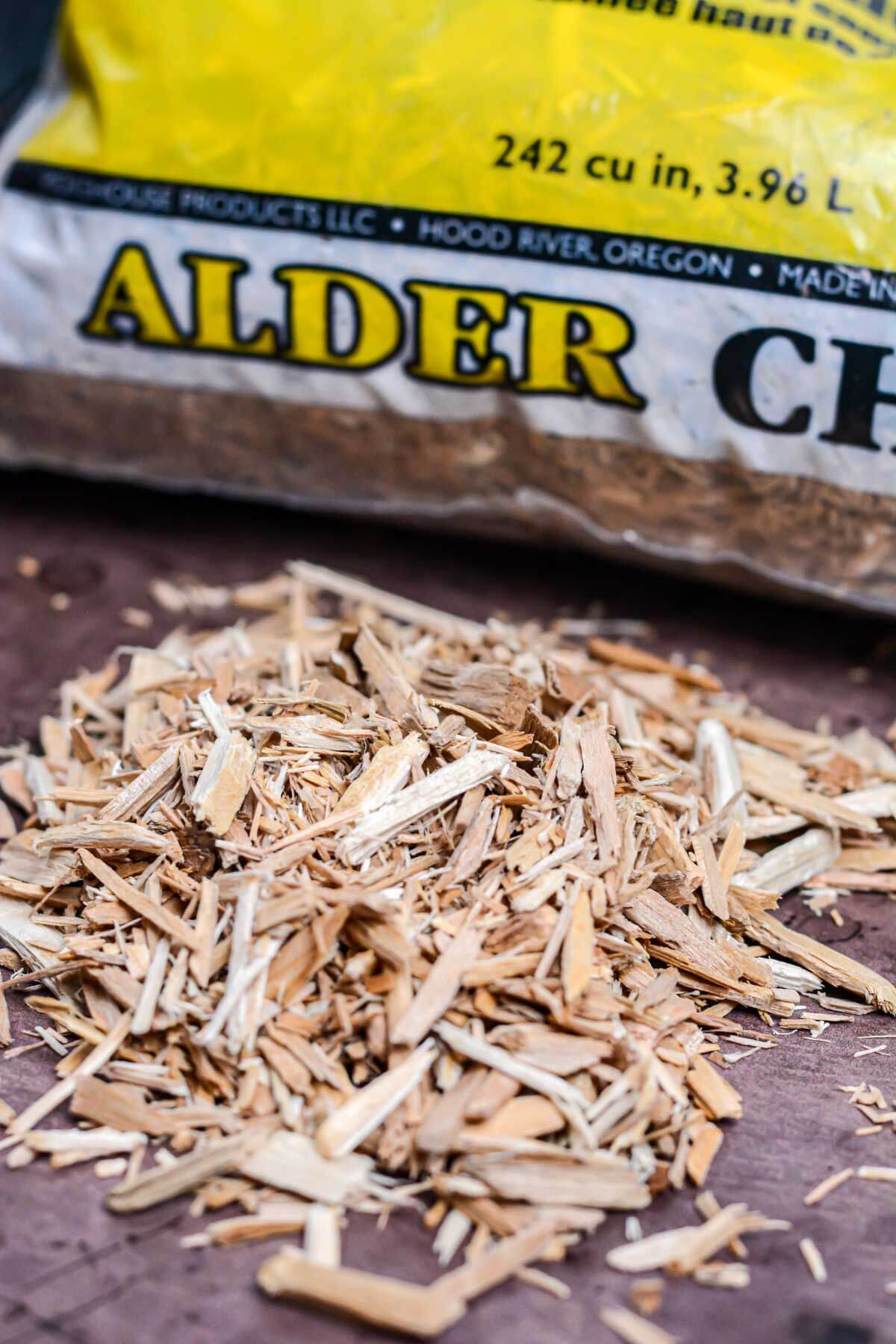
The delicate and subtly sweet smoke of alder wood makes it one of the best wood for smoked salmon, and it’s also great for other fish.
Besides smoked salmon, I also tried it for smoked trout, and smoked Pacific rockfish, and the light smoke flavor was fantastic!
Of course, this subtle and sweet smoke flavor also works for brisket, especially if you want to taste more of the beefy flavor of this meat.
Another strong point of this wood is it’s even, moderate burn. It will last for quite some time in the smoker so when you’re cooking large meat cuts you won’t need to open the smoker too often.
⭐Smoke Intensity | Mild, subtle.
⭐Flavor | Delicate, slightly sweet.
⭐Burning Time | Moderate, burns evenly.
Beech
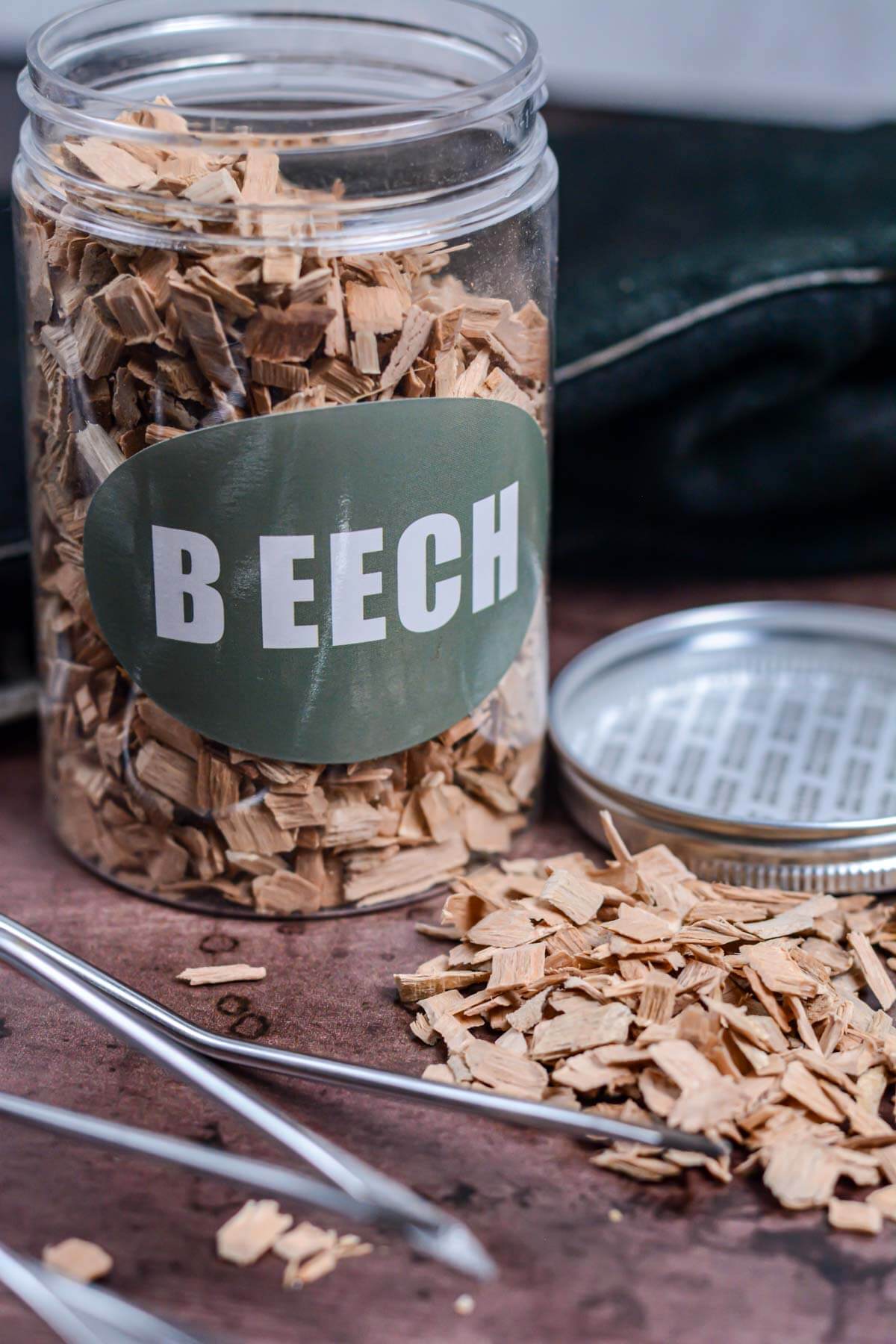
Whether you use a special seasoning on your brisket or you simply love the natural flavor of this meat, beech wood offers a neutral and mild smoke that will allow the other flavors of your meat to shine.
The neutral flavor of this wood makes it suitable for smoking almost any meat and it’s also great for blending with other stronger-flavored woods.
Last, but not least, the slow and steady burn makes beech wood a good option for longer smoking sessions.
⭐Smoke Intensity | Mild.
⭐Flavor | Neutral, mild.
⭐Burning Time | Long, steady burn.
Choosing The Right Wood Size
The wood used for smoking comes in various sizes, and let me tell you, size matters in this case.
Depending on the type of smoker or grill you’re using, you’ll need to choose a suitable size/style of wood as follows:
👉Logs: Reaching up to 18 inches long, this is the largest size of smoke wood. It’s best used in grand smokers or on a commercial scale and it takes the longest to burn.
👉Chunks: Measuring up to 4 inches, this size is most suitable for household full-size charcoal grills and smokers, as well as offset smokers (these can even use logs). I like to use wood chunks in the Big Green Egg.
👉Chips: If you’re cooking in a gas or electric grill/smoker, chips are the way to go. They produce smoke quickly and are easy to store. If you are using an electric or gas grill, you’ll need a smoking box to add the chips.
👉Disks: This style of smoke wood is best paired with electric smokers.
👉Pellets: There are several types of wood pellets: some are used for bedding, and there is even a type created specifically for wood pellet-burning stoves.
The ones you need are specially designed for use in pellet smokers and pellet grills. These are food-grade hardwood pellets and the label should indicate they are intended for use in cooking.
👉Sawdust: If you’re using a handheld, electric, or stovetop smoker, this form of wood can offer instant smoke.
Smoking Wood Tips For Brisket
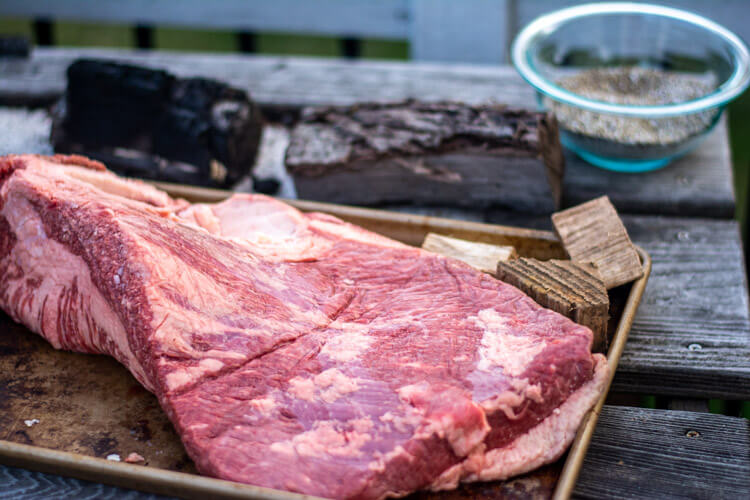
Now that you can make an informed decision about the best smoking wood to use for brisket and the proper size, it’s worth mentioning there are other things you need to consider when smoking this delicious cut of beef.
✔️Mix It Up | Combining different woods is a great idea to create a perfectly customized blend. Don’t be afraid to pair a strong variety like hickory or mesquite with a lighter smoking wood like apple or peach to balance the smoke flavor.
✔️Soaking The Wood | If you’re using wood chips, soak them in water for at least one hour before smoking. This will prevent them from burning too fast and allow them to produce smoke longer.
✔️Monitoring Wood Usage | Hardwoods like hickory and oak burn slower than softer woods like apple and cherry. You will need to keep an eye on the burn rate and adjust the amount of wood based on the total smoking time.
✔️Don’t Over-Smoke | Too much smoke and your brisket might get a bitter taste. Aim for light trickles of smoke by using a moderate amount of wood and check the brisket at regular intervals.
It’s easy to add more wood if needed but you can’t remove the smoke flavor that’s already infused into the meat. Words to live by!
✔️Good Airflow | As the smoking wood burns, there needs to be some airflow going through the smoker and remove some of it. The smoke should have a blueish tint and look thin.
If it’s thick and white, it’s too much and you need to open the vents a little more.
✔️Wood Chunks Or Chips | For charcoal smokers, you’ll want to use wood chunks when smoking low and slow like you do for brisket.
Wood chunks are better suited for longer smoking sessions. Wood chips are excellent for fast smoker recipes like this smoked ribeye.
✔️Bark Or No Bark | Wood chunks with the bark on can sometimes produce a harsher smoke flavor, according to some pitmasters.
I never experienced any trouble by leaving it on, but feel free to try removing it just once to see the difference.
✔️Consistent Temperature | It’s very important to maintain a constant smoking temperature if you want to achieve the perfect smoked brisket. Fluctuations can lengthen the cooking time and potentially dry out the meat, as well as affect the final flavor of your brisket.
Wrap Up
As you can tell by now, the choice of the best wood for smoking brisket ultimately comes down to your flavor preference and the type of smoker or grill you’re using.
Whenever you want to smoke meat, fish, seafood, or vegetables, consult our free wood smoking cheat sheet. Hopefully, you’ll have an easier time figuring out which type of wood to use.
The best brisket for smoking is the whole packer. This includes both the flat and the point. A whole packer brisket weighs 10-16 pounds and you should look for one that has an even thickness.
The fat cap should be intact (not cut or pierced) and about 1/4-1/2 inch thick. The fat that is rendered from it will keep the meat moist during cooking.
Also, make sure the brisket is fresh. The meat should have a deep red color and the fat should be milky white.
Yes, apple wood is actually a popular choice for smoking brisket. It imparts a mild, sweet, and subtle fruity smoke that pairs well with beef, including brisket. Those who find the intense smoky flavors of hardwoods like hickory and mesquite often choose apple wood or another mild fruit wood to smoke this beef cut.
Apple wood also pairs well with other types of wood and you can mix it with a stronger-flavor wood like oak or hickory.
The whole brisket, also known as a whole packer, is made up of two smaller cuts. The point cut (second cut) is more tender than the flat cut (first cut).
This is mainly because the point has more marbling that renders during cooking keeping the meat moist.
As a result, the point cut is more forgiving during the cooking process and there’s a lower chance of it ending up dry or chewy.
Related Brisket Articles

Ginny Collins is a passionate foodie and recipe creator of Savor and Savvy and Kitchenlaughter. Indoors she focuses on easy, quick recipes for busy families and kitchen basics. Outdoors, she focuses on backyard grilling and smoking to bring family and friends together. She is a lifelong learner who is always taking cooking classes on her travels overseas and stateside. Her work has been featured on MSN, Parade, Fox News, Yahoo, Cosmopolitan, Elle, and many local news outlets. She lives in Florida where you will find her outside on the water in her kayak, riding her bike on trails, and planning her next overseas adventure.






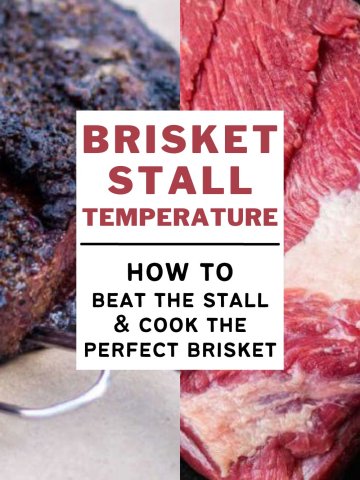
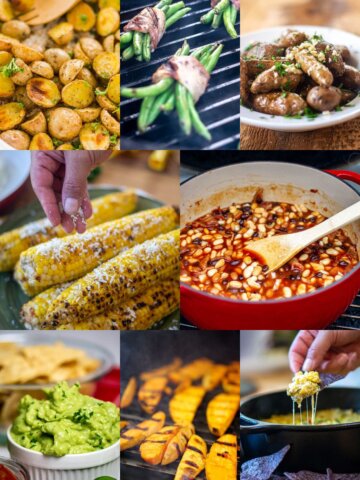
Leave a Reply